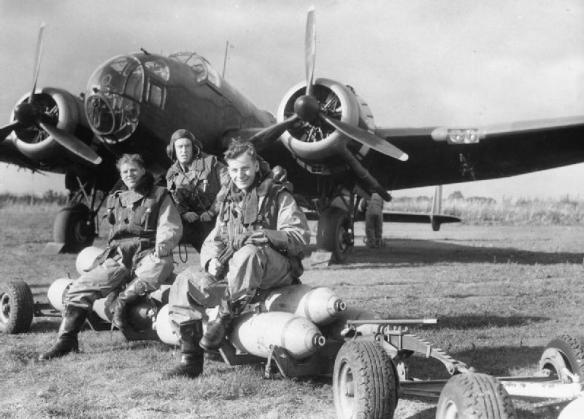
Handley Page Hampden of No. 83 Squadron with crew, seated on a loaded bomb trolley at Scampton, October 1940.
Handley Page Hampdens of RAF Bomber Command.
August 25, 1940 While late afternoon air battles end the day with 16 RAF aircraft lost and 22 German aircraft shot down. RAF Bomber Command launches a “reprisal” raid on Berlin in response to the bombing of London the night before. A force of over 70 Armstrong Whitworth Whitleys, Handley Page Hampdens and Vickers Wellingtons set out for Berlin.
The immense effort which had been expended in preparing the bomber force for war seemed to have been of no avail. When war finally came, Bomber Command – numerically weak in aircraft and acutely short of every type of air and ground equipment – was in no position to influence the outcome of events in the opening phase of the war. The Air Staff had no illusions about the war-readiness of the force, and it was their firm intention to confine its operational activities to leaflet dropping, reconnaissance missions and small-scale raids against naval targets. This resolve to conserve the force until the initial onslaught of the enemy had been warded off was strengthened by the Government’s ruling that no attacks should be made against targets which might put at risk the lives and property of enemy civilians. Whatever criticism may be levelled at the restricted bombing policy, it certainly worked as a shield to protect the bomber force from the heavy casualties it would undoubtedly have suffered if it had been launched upon a campaign of intensive raids in the first phase of the war. And if evidence is needed to support this assertion, it is to be found unequivocally in the experience gained from a number of small-scale raids carried out early in the war against the limited German naval targets which were permitted under the restricted ruling.
Before the end of 1939 Bomber Command had carried out a series of attacks against the German navy; and of these attacks four are of special importance, for they put to the test of battle the ability of the self-defending bomber formation to carry out its mission and survive against the new multi-gun fighters supported by early warning radar and anti-aircraft defences.
The first of these four raids was made on 4 September 1939, when, in bad weather conditions, ten Blenheims and nine Wellingtons attacked German warships in the Heligoland Bight. The Blenheims, making their attacks at low level (500 feet and below), encountered heavy and accurate anti-aircraft fire, and five of them failed to return. Some of the Wellingtons were engaged by Me 109 fighters and two failed to return. The experience of this raid was difficult to interpret, but it seemed to suggest that whereas the enemy anti-aircraft guns had proved effective the fighters had not.
Prolonged periods of bad weather combined with the difficulties of obtaining reliable and up-to-date information about the movement of enemy ships prevented another raid being attempted until 3 December. On that day, 24 Wellingtons, seeking out enemy ships in the Heligoland area, encountered heavy anti-aircraft fire and were attacked by Me 109 and Me 110 fighters. The bombers had some difficulty in maintaining their formations during the engagement but all returned safely to their bases. The most notable feature of the battle was the tendency of the German fighters to break off their attacks as soon as they came within range of the bombers’ guns.
The next encounter took place on 14 December when 12 Wellingtons carried out an armed patrol of the Schillig Roads. Weather conditions in the area were very bad. The bombers came under heavy fire from both naval and flak ships; again enemy single- and twin-engined fighters joined the battle, but on this occasion they pressed home their attacks with more determination. Five Wellingtons failed to return and one crash-landed on arriving at base. Again, it was impossible to determine with any certainty whether the anti-aircraft guns or the fighters had been the more dangerous. The Air Staff inclined to the view that the casualties had been the victims of gunfire, while the fighters had been thwarted in their attacks by the combined fire-power of the bombers flying in formation.
A few days later, on 18 December, the last of these raids took place. On that day, weather conditions, which on previous occasions had confounded both attackers and defenders, were perfect. The sky was cloudless and visibility almost unlimited when 22 Wellingtons, having aimed their bombs from 13,000 feet at enemy warships near Wilhelmshaven, were attacked by enemy fighters which, as on previous occasions, had been warned by radar of the bombers’ approach. The fighters pursued the bombers for some 80 miles on the homeward flight and pressed their attacks relentlessly. Only ten of the 22 bombers succeeded in reaching England, and of those, three made forced landings before reaching their bases.
The superiority of the fighter over the bomber in daylight was now proved beyond doubt, and Sir Edgar Ludlow-Hewitt, who had himself stated that the danger and difficulty of daylight operations must be measured by the distance of penetration into enemy territory which they involved, pointed out that none of the raids against the German navy had involved any real penetration of enemy territory. It was now clear that there was not the remotest possibility of attacking inland targets without suffering prohibitive losses. The Commander-in-Chief had therefore no alternative but to call a halt to the daylight operations, and from that moment on he began the conversion of Bomber Command into a force which would operate almost exclusively during the hours of darkness when the German air defences (like our own) were almost non-existent.